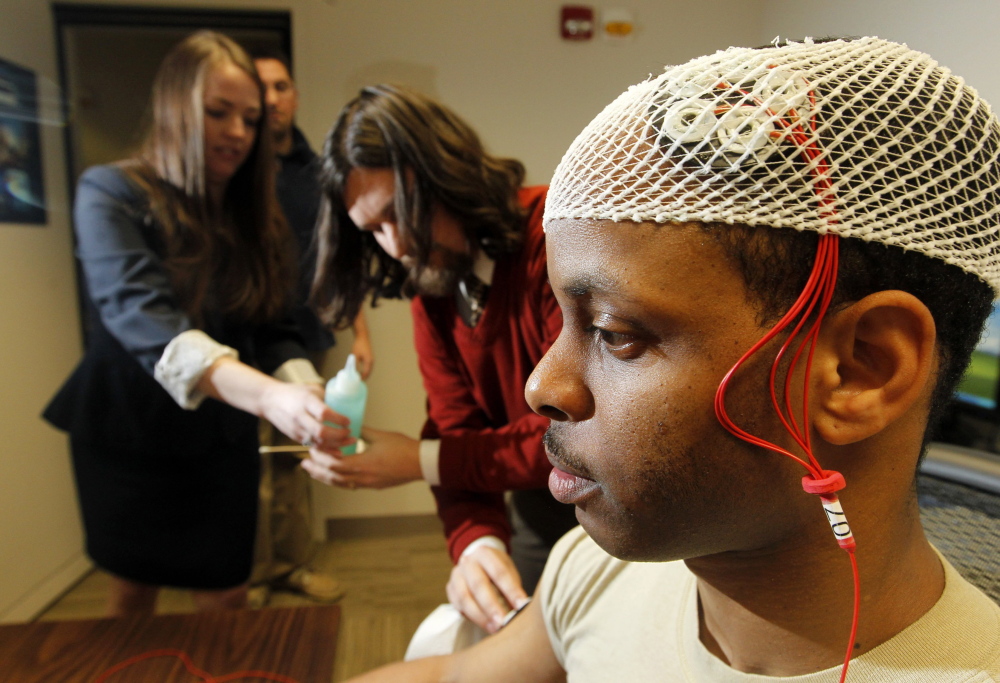WRIGHT-PATTERSON AIR FORCE BASE, Ohio — Tired troops may get a jolt out of a late-night caffeine boost, but researchers at the Air Force Research Laboratory say they may have found a better way to fight fatigue.
A mild electric stimulation has proven in a research study of about 175 volunteers to be more effective for longer times than caffeine, said R. Andy McKinley, a 711th Human Performance Wing biomedical engineer in the Human Effectiveness Directorate.
“We found this really helps keep your attention on task,” McKinley said.
Imagery analysts, cyber and unmanned aerial vehicle operators could be more alert with long hours staring at computer screens, and research findings suggest students could train up to twice as fast or more, researchers said.
“This would be a real benefit if we can accelerate that learning time, and our results have been really promising in that,” said Lindsey McIntire, a Human Performance Wing project research psychologist.
The technology could find its way into control rooms and classrooms within five years if the Air Force pursues the new fatigue-fighting method, McKinley said.
“I think we’re past the proof of concept phase and we’re trying to move toward something we can apply,” he said.
The technique is called trans cranial direct-current stimulation. Short term tests have shown few side effects, he said. But more research into the Air Force initiative, called Non-Invasive Brain Stimulation and tested on active-duty airmen at Wright-Patterson, is needed prior to fielding it.
“Basically, we need to understand what the effects will be of using this every day,” McKinley said.
The Wright State Research Institute expects to start similar experiments on student volunteers and airmen this spring in collaboration with Air Force research, said Michael P. Weisend, an Institute senior research scientist in the neuromedical imaging program.
“We will start to move this technology into more real-world situations,” he said.
Weisend arrived from the Mind Research Network in Albuquerque, N.M., to start the Wright State program.
“If you do this with carefully trained people in a lab setting, the risks are very low,” he said. But treatments at home by the inexperienced have in some cases led to burns or rashes, he cautioned.
The mild stimulation technique, narrowly focused on the brain, could be an alternative to pharmaceutical drugs spreading throughout the body and impacting other organs, he said.
“The normal solution to lots of problems we have with our brain is to take a drug,” he said.
The 711th Human Performance Wing has partnered with George Mason University, Georgia Institute of Technology and Duke University in the studies as well.
The Air Force study showed people who stayed awake 30 hours, and then had a mild electric stimulation for about half an hour stayed alert another six hours compared to an hour or two after consuming caffeine, McKinley said. They had a better mood, were less drowsy and more energized, researchers said.
Researchers tested memory and reaction times between electric stimulation and caffeine and found no notable difference, McKinley said.
Send questions/comments to the editors.



Success. Please wait for the page to reload. If the page does not reload within 5 seconds, please refresh the page.
Enter your email and password to access comments.
Hi, to comment on stories you must . This profile is in addition to your subscription and website login.
Already have a commenting profile? .
Invalid username/password.
Please check your email to confirm and complete your registration.
Only subscribers are eligible to post comments. Please subscribe or login first for digital access. Here’s why.
Use the form below to reset your password. When you've submitted your account email, we will send an email with a reset code.